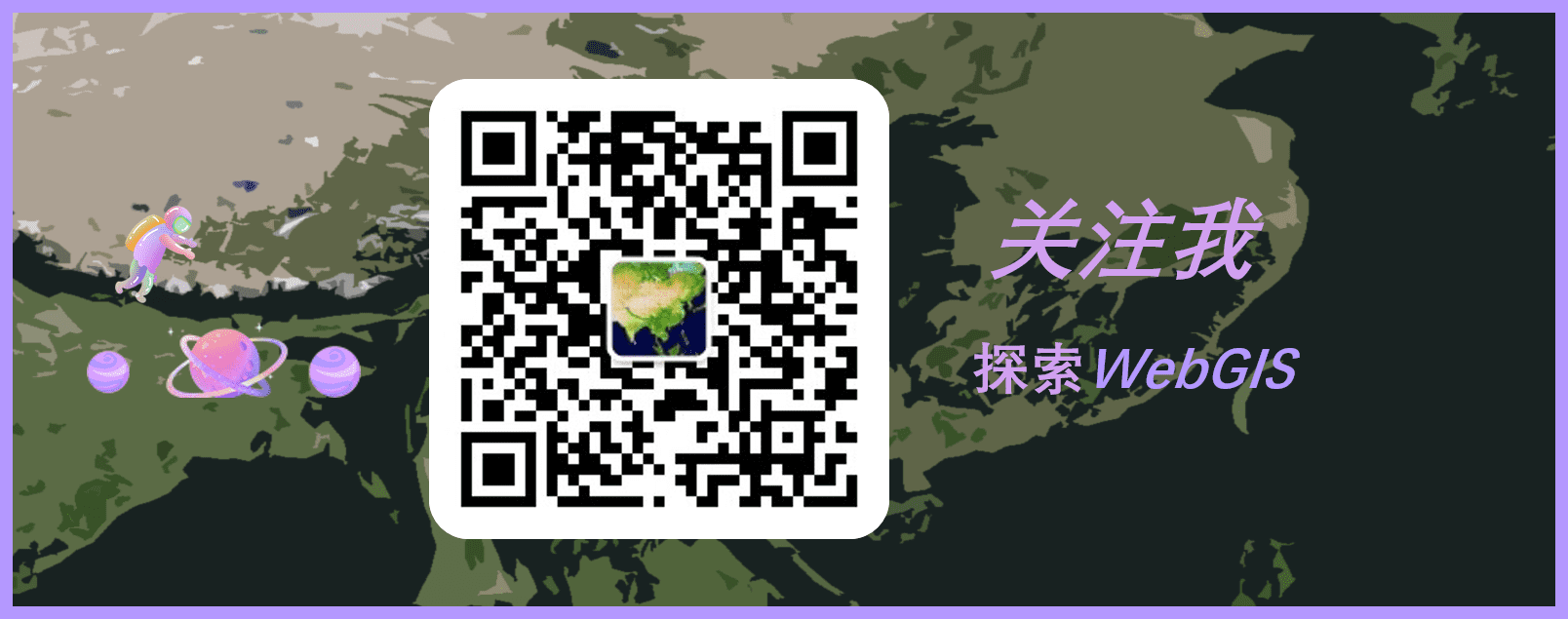阅读 166
^ 关注我,带你一起学GIS ^
 注:当前使用的是 ol 5.3.0 版本,天地图使用的
注:当前使用的是 ol 5.3.0 版本,天地图使用的key请到天地图官网申请,并替换为自己的key
随着GIS应用的不断发展,Web地图也越来越丰富,除了像ESRI、超图、中地数码这样GIS厂商有各自的数据源格式,也有Google、百度、高德、腾讯提供的GIS资源,如何加载各种GIS数据源,是WebGIS开发要解决的一个关键问题。
本节主要介绍加载GeoJSON数据。
1. 什么是GeoJSON
GeoJSON数据,顾名思义就是具有地理空间属性的JSON数据,组织结构与JSON相同,都是采用键值对的方式组织数据。
2. 如何加载GeoJSON数据
在页面上添加一个按钮,在该按钮上触发加载数据事件。通过VectorSource类创建矢量数据源,然后通过VectorLayer创建矢量图层,并将其添加到地图中。
// 创建矢量数据源
const vectorSource = new ol.source.Vector({
url: "../data/geojson/hubei.geojson",
format: new ol.format.GeoJSON()
})
// 创建矢量图层
vectorLayer = new ol.layer.Vector({
source: vectorSource,
// 设置样式
style: styleFunction
})
map.addLayer(vectorLayer)
3. 完整代码
其中libs文件夹下的包需要更换为自己下载的本地包或者引用在线资源。
<!DOCTYPE html>
<html>
<head>
<meta http-equiv="Content-Type" content="text/html; charset=utf-8" />
<title>加载geoJSON数据</title>
<meta charset="utf-8" />
<script src="../libs/js/ol-5.3.3.js"></script>
<script src="../libs/js/jquery-2.1.1.min.js"></script>
<link rel="stylesheet" href="../libs/css//ol.css">
<style>
* {
padding: 0;
margin: 0;
font-size: 14px;
font-family: '微软雅黑';
}
html,
body {
width: 100%;
height: 100%;
}
#map {
position: absolute;
width: 100%;
height: 100%;
}
.ol-mouse-position {
padding: 5px;
top: 10px;
height: 40px;
line-height: 40px;
background: #060505ba;
text-align: center;
color: #fff;
border-radius: 5px;
}
.load-div {
position: relative;
margin: 0 auto;
top: 50px;
width: 100px;
background-color: #060505ba;
text-align: center;
padding: 5px 10px;
color: #ddd;
border-radius: 2.5px;
filter: brightness(0.95);
}
.load-div:hover {
cursor: pointer;
/* font-size: 16px; */
transition: font-size .2s;
fill-opacity: 0.8;
filter: brightness(1);
color: #fff;
}
.load-btn {
border: none;
background: none;
}
</style>
</head>
<body>
<div id="map" title="地图显示"></div>
<div class="load-div" onclick="loadGeoJSON()">
<span>加载GeoJSON</span>
</div>
</body>
</html>
<script>
//数据类型
var ajaxDataType;
//地图投影坐标系
var projection = ol.proj.get('EPSG:3857');
//==============================================================================//
//============================天地图服务参数简单介绍=============================//
//================================vec:矢量图层=================================//
//================================img:影像图层=================================//
//================================cva:注记图层=================================//
//======================其中:_c表示经纬度投影,_w表示球面墨卡托投影==============//
//=============================================================================//
const TDTImgLayer = new ol.layer.Tile({
title: "天地图影像图层",
source: new ol.source.XYZ({
url: "http://t0.tianditu.com/DataServer?T=img_w&x={x}&y={y}&l={z}&tk=2a890fe711a79cafebca446a5447cfb2",
attibutions: "天地图注记描述",
crossOrigin: "anoymous",
wrapX: false
})
})
const TDTImgCvaLayer = new ol.layer.Tile({
title: "天地图影像注记图层",
source: new ol.source.XYZ({
url: "http://t0.tianditu.com/DataServer?T=cia_c&x={x}&y={y}&l={z}&tk=2a890fe711a79cafebca446a5447cfb2",
attibutions: "天地图注记描述",
crossOrigin: "anoymous",
wrapX: false
})
})
const map = new ol.Map({
target: "map",
loadTilesWhileInteracting: true,
view: new ol.View({
center: [11430576, 3030575],
zoom: 5,
worldsWrap: true,
minZoom: 1,
maxZoom: 20,
projection: projection
}),
// 鼠标控件:鼠标在地图上移动时显示坐标信息。
controls: ol.control.defaults().extend([
// 加载鼠标控件
new ol.control.MousePosition()
])
})
map.addLayer(TDTImgLayer)
//map.addLayer(TDTImgCvaLayer)
/**
*矢量几何要素的样式
*/
var image = new ol.style.Circle({
radius: 5,
fill: null,
stroke: new ol.style.Stroke({ color: 'red', width: 1 })
});
var styles = {
'Point': [
new ol.style.Style({
//点样式
image: image
})
],
'LineString': [
new ol.style.Style({
stroke: new ol.style.Stroke({
//线的边界样式
color: 'green',
width: 1
})
})
],
'MultiLineString': [
new ol.style.Style({
stroke: new ol.style.Stroke({
//多线的边界样式
color: 'green',
width: 1
})
})
],
'MultiPoint': [
new ol.style.Style({
//多点的点样式
image: image
})
],
'MultiPolygon': [
new ol.style.Style({
stroke: new ol.style.Stroke({
//多区的边界样式
color: 'yellow',
width: 1
}),
fill: new ol.style.Fill({
//多区的填充样式
color: 'rgba(255, 255, 0, 0.1)'
})
})
],
'Polygon': [
new ol.style.Style({
stroke: new ol.style.Stroke({
//区的边界样式
color: 'blue',
lineDash: [4],
width: 3
}),
fill: new ol.style.Fill({
//区的填充样式
color: 'rgba(0, 0, 255, 0.1)'
})
})
],
'GeometryCollection': [
new ol.style.Style({
stroke: new ol.style.Stroke({
//集合要素的边界样式
color: 'magenta',
width: 2
}),
fill: new ol.style.Fill({
//集合要素的填充样式
color: 'magenta'
}),
image: new ol.style.Circle({
//集合要素的点样式
radius: 10,
fill: null,
stroke: new ol.style.Stroke({
color: 'magenta'
})
})
})
],
'Circle': [
new ol.style.Style({
stroke: new ol.style.Stroke({
//圆的边界样式
color: 'red',
width: 2
}),
fill: new ol.style.Fill({
//圆的填充样式
color: 'rgba(255,0,0,0.2)'
})
})
]
};
var styleFunction = function (feature, resolution) {
//根据要素类型设置几何要素的样式
return styles[feature.getGeometry().getType()];
};
let vectorLayer = null
function loadGeoJSON() {
// 移除已有图层
if (vectorLayer != null || vectorLayer != 'undefined') {
map.removeLayer(vectorLayer)
}
const vectorSource = new ol.source.Vector({
url: "../data/geojson/hubei.geojson",
format: new ol.format.GeoJSON()
})
const extent1 = vectorSource.getExtent()
vectorLayer = new ol.layer.Vector({
source: vectorSource,
// 设置样式
style: styleFunction
})
map.addLayer(vectorLayer)
var view = map.getView();
// 移动到矢量图层
view.setCenter([12536865.056410152, 3635008.742201894]);
}
</script>
❝
OpenLayers示例数据下载,请在公众号后台回复:ol数据
全国信息化工程师-GIS 应用水平考试资料,请在公众号后台回复:GIS考试
❝
GIS之路公众号已经接入了智能助手,欢迎大家前来提问。
欢迎访问我的博客网站-长谈GIS:
http://shanhaitalk.com
都看到这了,不要忘记点赞、收藏+关注 哦!
本号不定时更新有关 GIS开发 相关内容,欢迎关注 


